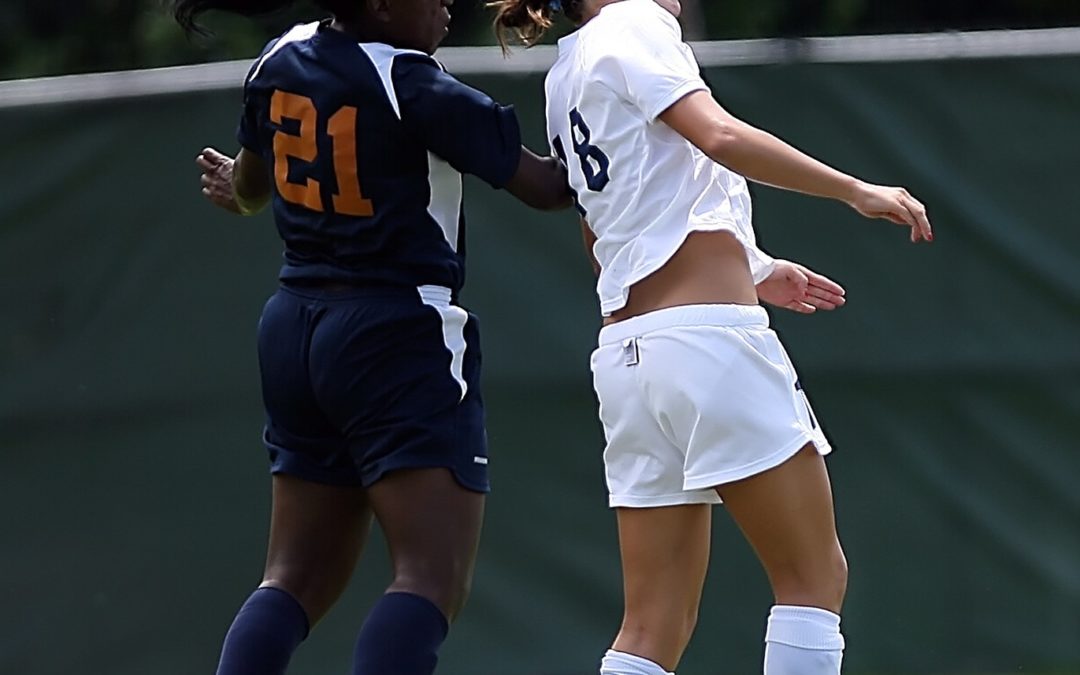Concussion-Prevention Strategies Used in National Collegiate Athletic Association Divisions I and II Women’s Soccer
Jeffries KK, Girouard TJ, Tandy RD, & Radzak KN. J Athl Train. 2020 55(5) Online ahead of print. doi: 10.4085/1062-6050-142-19.
Take-Home Message
Among women’s soccer programs, there is a discordance between what athletic trainers think will prevent concussions and what the teams are implementing.
Summary
Over the past 20 years, we’ve seen more research trying to identify concussion-prevention strategies. However, it is unclear what prevention strategies are being adopted in high-risk sports, such as women’s soccer. Hence, these authors studied whether NCAA I & II women’s soccer programs used concussion-prevention strategies and if athletic trainers thought these programs were effective. The study team sent surveys to 587 athletic trainers that provided the primary medical services to a women’s soccer program, and 222 responded. The survey included structured and open-ended questions to identify the use of cervical-strengthening programs, headgear, and other prevention strategies. Less than 20% of the athletic trainers indicated that the women’s soccer team implemented any stability or cervical strengthening training to prevent concussions. However, 70% of athletic trainers believed that cervical strength training could prevent concussions within women’s soccer. Interestingly, about one-third of the athletic trainers reported that players on the team wore headgear; however, < 10% of athletic trainers believed headgear could prevent concussions. The majority of athletic trainers (70%) reported that education on proper techniques was part of their concussion prevention strategy.
Viewpoints
This study is interesting because it shows that women’s soccer programs seem to be relying on education as the primary means for concussion prevention, despite believing that stability or strengthening programming would be beneficial. Many of the posts on Sports Med Res have focused on lower extremity injury prevention programming with much less high-quality evidence assessing concussion prevention in isolation. Programs such as the FIFA 11+ effectively reduce concussions. It would have been interesting to see if these women’s soccer programs were also using any type of general injury prevention programming that may have some carryover to concussion prevention. Most injury prevention warm-up programs do not incorporate neck strengthening into their programs, and this is a known risk factor for female soccer players’ risk of concussion. However, there is a need for more evidence to decide if cervical strengthening programs can reduce the risk of concussion. Despite the lack of evidence, 70% of athletic trainers think cervical strengthening may protect against concussion. The authors observed considerable discordance between implemented prevention strategies and athletic trainers’ belief in these programs. It would have been interesting to know who is making the final decision about which programs to implement and what role the athletic trainer had in these decisions. This may clarify why teams with athletic trainers that believe in cervical strengthening fail to implement the program. Alternatively, it may clarify why headgear is used when an athletic trainer thinks they won’t help. Overall, this research highlights a significant gap in clinical practice, and the need to understand better how teams decide to implement concussion-prevention strategies. It may be beneficial for clinicians to review who is making key decisions about prevention programs and to educate those stakeholders.
Questions for Discussion
Why do you think concussion prevention has taken so long to gain traction? What do you think we can do to improve awareness and implementation?
Written by: Nicole M. Cattano
Reviewed by: Jeffrey Driban
Related Posts
High Adherence to the FIFA11+ Decreases Injury Risk Among Youth Female Soccer Players
Youth Soccer Girls Heading Up in the Concussion Rates
Give a Heads Up to Your Club Sports on Concussions



I think concussion preventation has taken so long to gain traction because there has been limited research regarding the severity of concussions and the impact concussions has on a patient and its long term effects (CTE, post concussion syndrome, & second impact syndrome). I think it is important to educate both clinincians and atheltes on the negative risks associated with concussions. I believe it is also important to provide the necessary preventitive equipment for all sports that are considered high contact.
Thank you for your comment Allison.
Interestingly – there’s been a good amount of research on the education and attitudes of athletes about concussion. What is interesting is that while knowledge and awareness has increased, there is still a gap in intentions to report. Much of this centers around teammate and coach pressure.
You are right that the understanding of CTE is still an evolving field, but I think as clinicians we should absolutely focus our efforts on education and prevention. It would seem we need to focus some efforts on the sociocultural influences surrounding reporting.
Unfortunately, there’s not much research to support any preventative equipment – yet people are still using them. SO we may need to educate our patients, parents, and coaches better on the inefficacy of some of this equipment to make them an informed consumer. My hopes are that we can intentionally gear our preventative efforts towards things that have evidence behind them. This may be strengthening or balance training, but there is still so much more to learn.